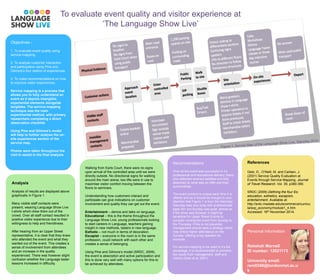Evaluation of event quality and visitor experience at тАШThe Language Show LiveтАЩ
- 1. Objectives - 1. To evaluate event quality using service-mapping. To evaluate event quality and visitor experience at 2. To analyse customer interaction and participation using Pine and GilmoreтАЩs four realms of experiences. 3. To make recommendations on how to improve visitor experiences. Service mapping is a process that allows you to fully understand an event as it depicts intangible, experiential elements alongside tangibles. The service-mapping technique was the main experimental method, with primary researchers completing a direct observation checklist. Using Pine and GilmoreтАЩs model will help to further analyse the on-site experiences section of the service map. Photos were taken throughout the visit to assist in the final analysis. тАШThe Language Show LiveтАЩ Analysis Analysis of results are displayed above graphically in Figure 1. Many visible staff contacts were present, wearing Language Show Live t-shirts which drew them out of the crowd. Over all staff contact resulted in positive visitor experience due to their willingness to help and friendliness. After hearing from an Upper Street representative, it is clear that they knew who attended the event and what they wanted out of the event. This creates a sense of involvement from attendees and an increase in the quality experienced. There was however slight confusion whether the Language taster lessons increased in difficulty. References Getz, D., OтАЩNeill, M. and Carlsen, J. (2001) Service Quality Evaluation at Events through Service Mapping, Journal of Travel Research. Vol. 39, p380-390. SRDC (2009) Defining the four Es; education, esthetics, escapism, entertainment. Available at: http://srdc.msstate.edu/ecommerce/curricu la/exp_economy/module1_4.htm Accessed: 16th November 2014. Personal Information Rebekah Marnell ID number: 12021173 University email: rem0348@londonmet.ac.u k Recommendations Over all the event was successful in itтАЩs professional and educational delivery. Many who attended seemed satisfied and fully absorbed by what was on offer and their surroundings. The event product is unique each time it is offered and so it should be brought to your attention that Figure 1 is from the Saturday. Saturday was very busy with professionals aged 30+ but Sunday was quiet, almost as if the show was finished. It might be beneficial for Upper Street Events to consider moving the event from Sunday to the Thursday. If this is not plausible, management should seek a strategy which may entice higher attendance on the Sunday; offering a key speaker for example. For service-mapping to be used to itтАЩs full advantage, it is recommended to combine the inputs from management, staff and visitors (Getz et al, 2001). Walking from Earls Court, there were no signs upon arrival of the controlled area until we were directly outside. No directional signs for walking around the main arena; two lifts were in use to maximise visitor comfort moving between the floors to seminars. Understanding how customers interact and participate can give indications on customer involvement and quality they can get out the event. Entertainment тАУ demos and talks on language. Educational тАУ this is the theme throughout the Language Show Live; young professionals looking to start careers in Language, teachers gaining insight in new methods, tasters in new language. Esthetic тАУ not much in terms of decoration. Escapist тАУ everyone in the room is in the same profession, could network with each other and creates a sense of belonging. Using Pine and GilmoreтАЩs model (SRDC, 2009), the event is absorption and active participation and this is done very well with many options for this to be achieved by attendees.
